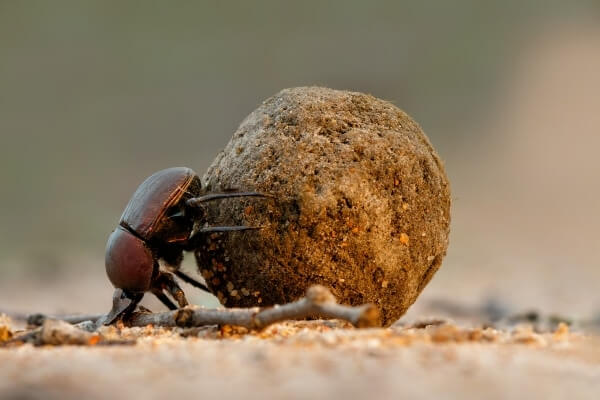Insects solve problems that machines still can’t, says Professor Javaan Chahl, DST Joint Chair of Sensor Systems at the University of South Australia.
Chahl and his team are pioneering new research aimed at enhancing navigation systems in drones, robots, and satellites. How, you may ask? By drawing inspiration from an insect species – the dung beetle – that has been navigating the earth for 130 million years.
The dung beetle is known for its ability to roll dung balls in a straight line at night. It achieves this feat by orienting itself with the Milky Way, a skill discovered by Swedish scientists in 2013. The insect species studied by them is found in Southern Africa, where the Milky Way is particularly visible. Unlike individual stars, which can blur during movement, the Milky Way provides a stable reference point for the dung beetle’s navigation.
Building on this discovery, Chahl’s team of PhD students conducted a series of experiments using a camera mounted on a vehicle, capturing images of the Milky Way in both stationary and moving conditions. They found that the Milky Way’s large light strip remained unaffected by motion blur, making it a reliable tool for navigation.
The UniSA researchers have now developed a computer vision system that accurately measures the Milky Way’s orientation. This innovation could serve as a backup navigation method for satellites and help drones and robots navigate in low light conditions, where traditional systems struggle.
Their findings have been published in the journal Biomimetics.
Leap in navigation technology
Chahl and Yiting Tao, lead author of the UniSA research, were aware of the study on dung beetle navigation done at Lund University. But they were wondering what the technological implications were of this sort of orientation system.
“We were seeking a deeper insight than just making a sort of compass,” says Chahl, when asked what inspired his team to do this research. “We were thinking about both insect evolution, and technological developments, and possible ecological consequences of artificial light on the navigation systems of insects.”
The AI sensor that Chahl’s team is developing can accurately measure the orientation of the Milky Way in low light. When asked what challenges his team faced in building this, Chahl said: “The Milky Way is a difficult photographic subject, and also difficult for computer vision systems to identify and measure. It is comparatively dim, and a mixture of bright stars, dark patches and the characteristic milky area. We struggled with exposure control on still and video cameras at first, Yiting had to give herself a crash course on DSLR astrophotography.”
The other major problem was obtaining data.
“We captured quite a lot of data in remote locations outside Adelaide, but we needed more time and places to develop a generally applicable solution,” he continued. “We used data from observatories that stream their feed to the web and also some outputs from simulated planetarium software.”
The future of navigation
But what benefits could this new navigation system provide for drones and satellites compared to existing methods?
“The possibility to have a more sensitive camera that has low resolution but high shutter speed might allow celestial navigation and stabilisation solutions on smaller, cheaper or different aerial and ground systems,” Chahl explained.
It would also increase the number of options for extremely small aircraft or highly dynamic aircraft, he added.

“It might also create options for orientation solutions on planets such as Mars, where the magnetic field is not reliable enough for navigation. There are likely to also be satellite stabilisation applications.”
But does this technology have any potential real-world applications beyond drones and satellites, we ask.
“We are becoming interested in what the sensor might tell us about ecological effects of light pollution,” Chahl told Indian Link. “The main reason we can’t see the Milky Way in many parts of the world is light pollution and regular chemical pollution. There are concerns that night flying pollinating insects such as moths might have their life cycle disrupted by loss of visibility of the Milky Way. Our techniques might be a way to objectively measure the effect of light pollution and even demonstrate what the effect is. Loss of necessary navigation signals might be enough to cause entire species of insects to become extinct, creating an unknown cascade of subsequent environmental issues.”
Insects lead the way
The sun helps many insects to navigate during the day, including wasps, dragonflies, honeybees, and desert ants. At night, the moon also provides a reference point for nocturnal insects, but it is not always visible, hence why the Milky Way is used for some moths and dung beetle navigation.
Chahl says insect vision has long inspired engineers where navigation systems are concerned.

“Insects have been solving navigational problems for millions of years, including those that even the most advanced machines struggle with. And they’ve done it in a tiny little package. Their brains consist of tens of thousands of neurons compared to billions of neurons in humans, yet they still manage to find solutions from the natural world.”
Insects solve problems that machines still can’t, he reiterated.
“In many cases, we don’t even know what problems might need to be solved by a highly autonomous and self-sustaining robot. Looking over the shoulder of evolution can provide a short cut to a deep understanding of the challenges ahead in robotics.”
READ MORE: Chris Bowen: India a ‘top-rank’ renewable energy partnership




